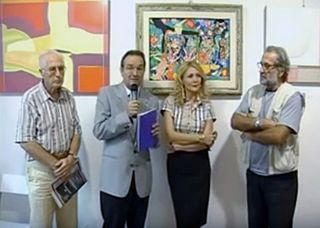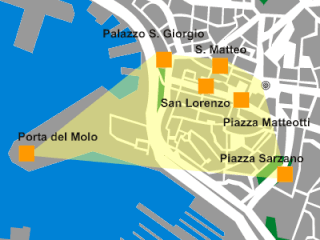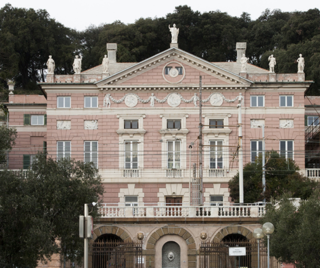
Albaro is an affluent residential neighbourhood of the Italian city of Genoa, located 3 kilometres (1.9 mi) east of the city centre. It was formerly an independent comune, named San Francesco d'Albaro, included in the city of Genoa in 1873. At present, together with the neighbourhoods of Foce and San Martino d'Albaro is part of the Genoa's city VIII Municipio.

The Church of Saint Anne, with the adjacent convent and pharmacy of the Discalced Carmelites, is a Roman Catholic church located in the residential quarter of Castelletto in Genoa, Liguria, north-western Italy. The village - now surrounded by the city - is still intact, with its leafy trees, cobbled walkways and open views from Salita Bachernia over the Gulf of Genoa, the harbor and the Old City.
Rocco Borella was an Italian painter. He was one of the most famous Italian painters of the avant-garde Italian Art movement from 1950 to 1970. He was also considered a master of color like Mark Rothko. Borella experimented with informal art, minimalism, and rationalism.

Claudio Costa was a Contemporary Artist from the 1970s avant-garde movement.
Castelletto is a residential quarter of Genoa, north-western Italy. It occupies a hilly area which, until the construction of the New Walls in the 17th century, was located outside of the city. The quarter is now part of the city's Municipio I Centro Est and comprises three urban units which, as of 31 December 2010, had a total population of 28,857 combined.

Mauro Marrucci was an Italian artist born in Volterra, Italy on December 18, 1937, by artisans parents and he died November 15, 2014, in Grosseto. Since 1950 he is acting as the Alabaster craftsman and wood and began his artistic research, released by academic schemes, as a graphic designer and painter and makes experiences in the field of sculpture. In 1861 he won first teaching assignment in Tuscany where he continues to practice as a graphic designer, painter and designer. Since 1973, public writings of artistic teaching and non-fiction. In December 1974 on Public Education of drawing the essay "The educational dialogue through the work of art." He also collaborates with the magazine School and cities. In 1982 he moved to Milan to teach Design and Art History at the XIII High School. In 1986 he held the chair of architecture at the Art School "Pietro Aldi" in Grosseto until retirement. From 1957 to 2011 he took part in demonstrations in graphics and painting in Italy and abroad, receiving reports from the most qualified critics and several awards.

Molo is a neighbourhood in the old town of the Italian city of Genoa. It was one of the six sestieri of ancient Genoa. At present is part of the Genoa's city Municipio I.

Jennifer Guidi is an American painter.

Villa Madre Cabrini, formerly Villa Acquarone, is a villa in the Castelletto quarter of Genoa, Liguria, Northwestern Italy. It is situated in a panoramic location on the hill of Bachernia, commanding open views over the Old City, the harbor and the Gulf of Genoa. Throughout its history, the villa has played an important role in the urban development and cultural life of the quarter. In the 18th century, it was one of the first suburban villas built in the old hamlet of Bachernia, giving impulse to the urbanization of the area. Then the property of the noble Acquarone family, the villa and its owner, Pietro Acquarone, II Count d'Acquarone, were in the 19th century at the heart of establishment of the economically and culturally active via Acquarone neighborhood.

Villa Pallavicino delle Peschiere is a 16th-century villa in Genoa, Northwestern Italy, built in 1560 for the nobleman Tobia Pallavicino. It is situated in via San Bartolomeo degli Armeni 25, in the quarter of Castelletto, in an area that, at the time when the villa was built, was still outside of the city walls. After the urban expansion of the 19th century, it is now located in the center of the city. The villa still belongs to the Pallavicino family.

Villa Di Negro Rosazza "dello Scoglietto" or "lo Scoglietto" is a villa located in the quarter of San Teodoro in Genoa, Northwestern Italy. It was built in 1565 for the Doge Ambrogio Di Negro o for his son Orazio, in a coastal area that used to be outside of the city walls. The villa passed to the Durazzo family, who commissioned a renovation in the neoclassical style at the end of the 18th century. In the 19th century, the construction of the railway Turin-Genoa led to the destruction of the garden at the sea side, while the hill side remained largely untouched. The villa and the park are now owned by the Municipality of Genoa and destined to public use. The villa is located near the Dinegro station of the Metro of Genoa.

Villa Balbi Durazzo Gropallo "Dello Zerbino" is a 16th-century villa in Genoa, Italy. It is situated in the quarter of Castelletto, near Galeazzo Alessi's Villa delle Peschiere. It was constructed from 1599 to 1603 as a suburban villa for the Genoese noblemen Stefano Balbi, ambassador to Milan, and Giovanni Battista Balbi. The name Zerbino is derived from the Ligurian word zerbo, meaning "uncultivated"— at the time when the villa was built, the surrounding area was still outside of the city walls and uncultivated. In the 18th century it passed to Marcello III Durazzo, then to the Gropallo family. It is now owned by the Castelbarco Albani family and used as a venue for events and exhibitions.

The Museo d'Arte Sacra della Val d'Arbia is a small museum of religious art in Buonconvento, in the Val d'Arbia to the south of Siena, in Tuscany in central Italy. It contain a number of paintings by important artists of the Sienese School, among them Duccio di Buoninsegna, Sano di Pietro and Pietro Lorenzetti. The museum is housed in the Palazzo Ricci Socini, close to the parish church of Santi Pietro e Paolo.
Ezia Gavazza was an Italian art historian. Along with her friends and colleagues Lauro Magnani and Piero Boccardo, she was one of the most prolific writers in Genoa on Baroque art. She specialised in the Ligurian Baroque, particularly Domenico Piola, Giulio Benso, Giovanni Andrea Ansaldo, Grechetto and Bernardo Strozzi.

The Villa Grimaldi Fassio is an 18th-century rural palace, now museum, and rose garden located on Via Capolungo 9 of Nervi, the eastern coastal quarter of the city of Genoa, region of Liguria, Italy. The property was purchased by the municipality of Genoa, is part of a series of parks and museums of the Gallerie d'Arte Moderna which include the Giannettino Luxoro Museum, the Wolfsonian Museum, and the museum at Villa Saluzzo Serra. The Villa Grimaldi Fasso is the home of the Raccolte Frugone since 1993.

The Loggia della Mercanzia is one of the most representative buildings in the historical centre of Genoa. It is located in Piazza Banchi, at the corner with Via San Luca, in the ancient sestiere of the Maddalena, not far from the church of San Pietro in Banchi, in the commercial heart of the ancient city.
Luigi Rovelli (1850–1911) was an Italian architect, a key figure in the eclecticism movement in Liguria.

Carignano is a residential district in the center of Genoa, administratively included in Municipio I Centro Est.

San Vincenzo is a central district of Genoa, administratively included in the Municipio I Centro Est. Located a short distance from Brignole train station, it includes part of the very central Via XX Settembre, the main artery of Genoa's commercial area.























